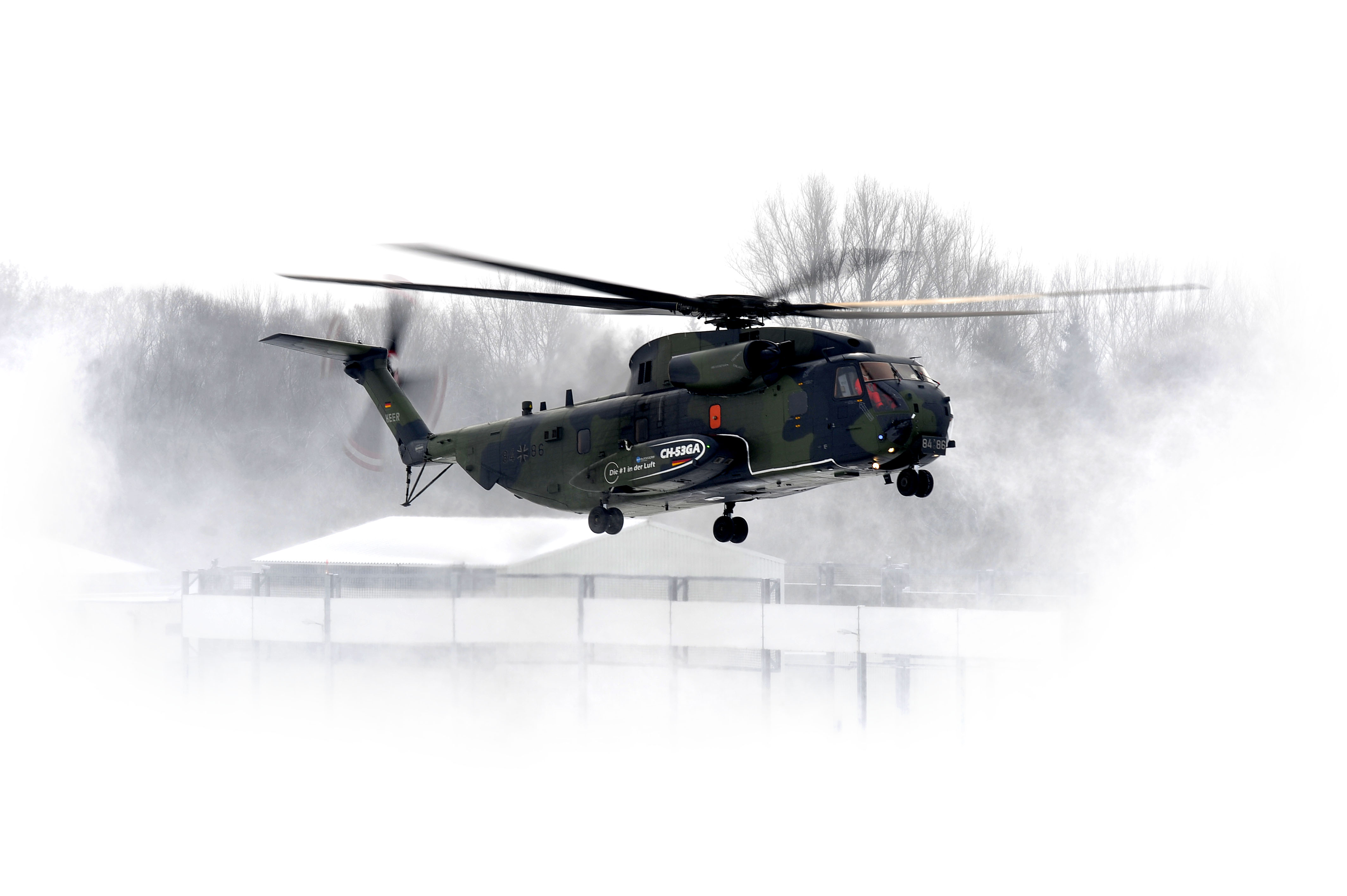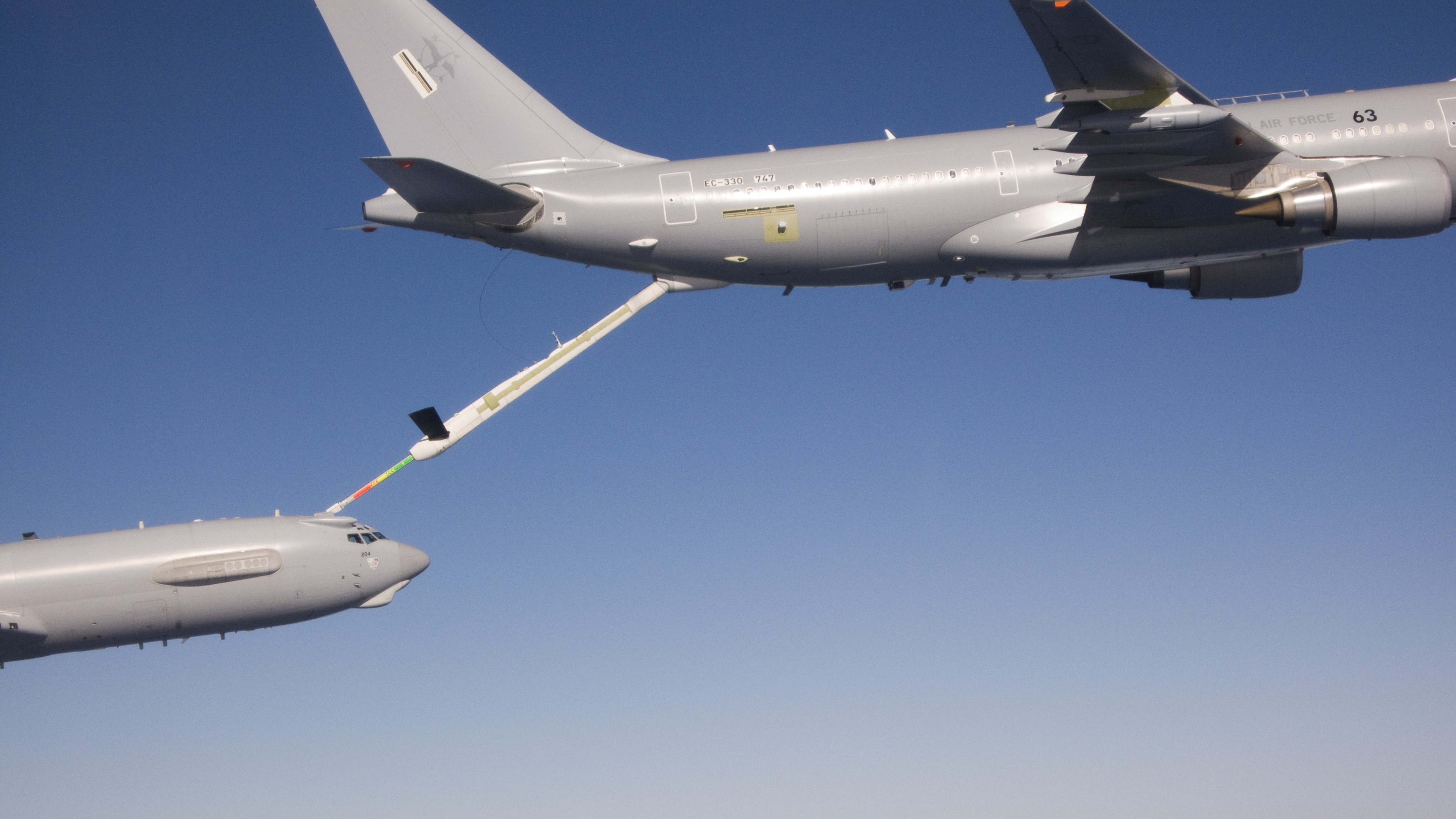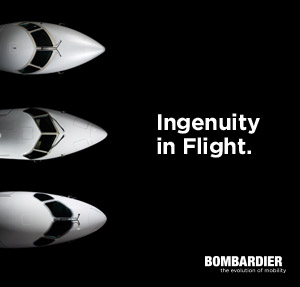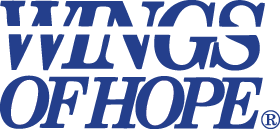Airbus Military awarded civil certification from European Authority
March 17, 2010
Airbus Military has obtained the civil Supplemental Type Certificate (STC) from the European Aviation Safety Agency (EASA) for the A330 Multi Role Tanker Transport (MRTT) aircraft. This certification is for the military additions and modifications to the basic passenger A330-200 which had been certified in 1998 prior to entry into commercial service. It is the first civil certification ever extended by EASA to a Tanker and Transport aircraft developed in Europe.
The Supplemental Type Certificate was handed over to Airbus Military Senior VP Miguel Angel Morell by EASA Certification Director Dr Norbert Lohl on Wednesday 17th March in Cologne, Germany.
The modifications installed in the A330 MRTT include all the equipment to ensure refueling of receiver planes such as fighters but also other large aircraft. This covers the operations of the totally new Airbus Military developed fly-by-wire Aerial Refueling Boom System (ARBS), the pods, the operating console installed in the cockpit of the aircraft, as well as other military modifications applied to the avionics. The flight control laws of the aircraft were also modified and adapted to the needs of performing refueling operations.
The certification follows a period of flight tests during which more than 170 test flights were performed. Of these, more than 60 were for the tests required for the STC, while the others were for the design validation and certification of military aspects. During these trials, some 320 wet and dry contacts were performed, involving fighter aircraft such as F-16s and F-18s, as well as the 707 (E3) AWACS. During these contacts, some 140 tonnes of fuel were transferred to the receiver aircraft. In addition some 190 contacts were made with the A330 MRTT acting as a receive. All systems as well as the aerodynamic performance of the aircraft were responding as expected.
“Receiving this Supplemental Type Certificate gives us great satisfaction. After many years of hard work, it confirms the readiness and quality of our product which complies with the stringent civil certification requirements”, said Miguel Morell when receiving the document. “I would like to thank all those who worked hard on all fronts to make this milestone possible. The next step is receiving the Military Certification prior to delivery of the aircraft to the first operator, in this instance the Royal Australian Air Force”.
The military certification by the Instituto Nacional de Tecnología Aerospacial (INTA) is expected this summer, with two A330 MRTT aircraft due to be delivered to the RAAF prior to year end.
First A400M ferried from Seville to Toulouse
March 10, 2010
The first A400M is flying today from Seville to Toulouse following a test flight performed in the Seville area. This flight is the tenth performed by A400M MSN1 since its first flight on 11th December 2009. In total and until yesterday the aircraft has logged 39 hours of flight test. Very poor weather in Seville prevented the aircraft from performing more flights, as the sensors installed on the turboprop blades for the initial flight test campaigns, are sensitive to humidity.
During the initial testing, MSN1 has flown at the type’s maximum operating speed of 300kt (555km/hr), maximum Mach number of M0.72, down to the stall warning, and at an altitude of more than 30,000ft. It has operated extensively in both direct and normal control laws, and in different configurations.
The first A400M is equipped with heavy test instrumentation, as is the second aircraft which was handed over to Flight Test on 6th March and is due to fly in the next few weeks. MSN 3 is undergoing final production ground tests before engine installation. The aircraft is due to fly by the middle of this year. Sections for MSN 4 have arrived in Seville for final assembly, with the main fuselage due to leave Bremen and be flown to Seville at the end of this week. MSN 4 is to fly in the second half of this year.
While MSN 1 and 2 are fitted with heavy test instrumentation, MSN 3 and 4 will have medium test instrumentation. The fifth aircraft, MSN6, which is the first built to production standards, is going to be fitted with light test instrumentation only. The five aircraft will perform a planned 3,700 flight-hours before first delivery of the A400M in late 2012. Trials with MSN1, 3 and 6 will be performed in Toulouse, while those with MSN 2 and 4 will be done in Seville, providing greater flexibility and taking advantage of best weather conditions where available.
Hawker Beechcraft Delivers 500th T-6 Military Trainer to U.S. Government
March 10, 2010
WICHITA, Kan. (March 8, 2010) – Hawker Beechcraft Corporation (HBC) this week announced the delivery of the 500th Beechcraft T-6 military trainer to the United States Government. The milestone aircraft, a T-6B, went to the U.S. Navy and will be based at Naval Air Station Whiting Field in Milton, Fla. Deliveries began in 2000 after the aircraft was initially selected to fill the Joint Primary Aircraft Training System role for the U.S. Air Force (USAF) and the U.S. Navy (USN) in 1996.
“The T-6 and its derivatives are now in service around the world,” said Jim Maslowski, president, U.S. and International Government Business. “It has met and surpassed the performance and durability requirements set in the original procurement and has shown it will continue to be an exceptional training platform for many years to come.”
The T-6 offers military organizations worldwide the most proven and most cost-effective training system available today. As a primary trainer aircraft it accommodates instruction in instrument flight procedures and basic aerial maneuvers. To date, it has been used to train pilots in approximately 20 different countries.
Hawker Beechcraft has a rich heritage of meeting military mission needs and has been delivering aircraft certified to military specifications for more than 50 years. Today, 100 percent of USAF student pilots and 100 percent of USN student pilots train in aircraft made by Hawker Beechcraft. In addition to the T-6, Hawker Beechcraft is rolling out a light attack version of the aircraft, the AT-6. With one prototype flying and a second prototype planned to enter flight test in 2010, the integration and flight test efforts are proceeding on parallel paths in order to meet rapidly emerging needs for irregular warfare capabilities around the world.
Hawker Beechcraft Corporation is a world-leading manufacturer of business, special-mission and trainer aircraft – designing, marketing and supporting aviation products and services for businesses, governments and individuals worldwide. The company’s headquarters and major facilities are located in Wichita, Kan., with operations in Salina, Kan.; Little Rock, Ark.; Chester, England, U.K.; and Chihuahua, Mexico. The company leads the industry with a global network of more than 100 factory-owned and authorized service centers.
“Eurocopter reinforces its commitment to India at Defexpo 2010”
February 16, 2010
Marignane, February 12, 2010 Defexpo 2010
Eurocopter, the world leading helicopter manufacturer, will show a significant presence at Defexpo 2010, with its star product, the AS 550 C3, participating in the ongoing trials for the Reconnaissance and Surveillance Helicopter requirements of the Indian Armed Forces. The premiere defence Airshow in Asia, being organized by the Indian Ministry of Defence will see Eurocopter present its range of military helicopters and state-of-the-art technology.
As Norbert Ducrot, Eurocopter Senior Vice President Sales & Marketing Asia points out,
“By participating in the key RFPs with our best products, we hope to continue to support India acquire the right mission equipment and develop a strengthened aerospace industry. Over the next few months we will also further our relationship with India by exploring opportunities for setting up joint ventures with our long time partners and establish a stronger footprint to provide end-to-end service to the country. “
The AS550 C3 which is undergoing trials for the Indian Army and Air Force requirement of Reconnaissance and Surveillance Helicopters will be one of the key products to be showcased at the event. Also showcased will be specification and mock-up models of the EC 725, which is Eurocopter’s key offering for the Indian Multi-role Helicopter requirements and the Panther, which is best suited for the requirements of the Indian Coast Guards.
With reference to both the Indian military and civil markets, Eurocopter currently holds a leading position achieved through strong partnerships. In the military space, Eurocopter has had a fruitful association with India for over 4 decades through two co-operation agreements with Hindustan Aeronautics Limited (HAL).The relationship started with a license production enabling HAL to manufacture more than 600 helicopters of the Alouette 3 and Lama type (Cheetah/Chetak). In 1984, HAL associated with Eurocopter in the development of the Advanced Light Helicopter. The cooperation with HAL has been further strenghtened with Eurocopter outsourcing metallic and composite work packages and today, HAL is part of Eurocopter global supply chain by producing Ecureuil/Fennec airframes, joining the ranks of very few select tier one suppliers.
In the civil space, Eurocopter has successfully formed partnerships in both public and private sector with Pawan Hans Helicopter Limited and Indocopters. These partnerships cover the entire spectrum of helicopter activities, from manufacturing to operations, maintenance and product support.
Eurocopter celebra el primer vuelo del helicóptero militar CH-53GA en la fecha prevista
February 16, 2010
Donauwörth, 10 de febrero de 2010
El helicóptero medio de transporte CH-53GA ha llevado a cabo su vuelo inaugural en el cielo bávaro de Donauwörth y en presencia de cerca de 150 invitados. A los mandos del helicóptero militar iban Rene Nater, piloto de pruebas de Eurocopter, y Antoine Van Gent, ingeniero de vuelo. Este primer vuelo se produce justo tres años después de la firma del contrato y significa un hito importante, tanto para el programa CH-53GA como para el centro de apoyo de Eurocopter Deutschland a los helicópteros del Ejército alemán. Las mejoras introducidas prolongarán la vida útil de este helicóptero hasta el año 2030. Una vez terminados los vuelos de entrenamiento, a principios de 2011, las primeras entregas de los helicópteros modernizados tendrán lugar ese mismo año. Las Fuerzas Armadas alemanas podrán entonces desplegar estos CH-53GA dotados de modernos equipos en misiones internacionales (por ejemplo, en Afganistán).
Como vicepresidente de contratos militares alemanes de Eurocopter Deutschland GmbH, Ralf Barnscheidt precisó: “En los últimos 30 años, el centro de apoyo de Eurocopter para los helicópteros del Ejército alemán ha realizado muchas importantes modernizaciones en los helicópteros de transporte CH-53G, trabajando en cooperación con la Oficina Federal de Tecnología de Defensa y Adquisiciones BWB (Bundesamt für Wehrtechnik und Beschaffung). Me complace enormemente ver al CH-53GA en vuelo hoy, como una prueba más de la exitosa colaboración con las Fuerzas Armadas alemanas, que nos ha llevado a hacer realidad el programa en plazo y dentro del presupuesto”.
Requisitos funcionales: transformación óptima
El CH-53G ha sido modernizado para que el helicóptero se pueda desplegar en una amplia gama de misiones nacionales e internacionales. Los requisitos funcionales esenciales exigidos al CH-53GA han sido definidos y cumplidos:
•
Mejora de los instrumentos de indicación y sistemas de control de vuelo con aviónica avanzada.
•
Sistema de navegación de precisión avanzado y mejora de las capacidades de vuelo, en línea con las regulaciones internacionales de vuelo instrumental (IFR).
•
Integración de un nuevo sistema de control de vuelo automático (AFCS, con piloto automático de cuatro ejes), con vuelo estacionario automático.
•
Instalación de depósitos de combustible auxiliares en la cabina para incrementar el alcance hasta 1.200 km.
•
Modernización de los equipos de comunicaciones para misiones conjuntas con los helicópteros Tigre y NH90.
•
Integración de un conjunto de equipos modulares de misión, incluyendo un sistema de observación por infrarrojos FLIR (Forward Looking Infrared System), sistema de comunicación por satélite (SatCom), así como un moderno sistema de guerra electrónica EWS (Electronic Warfare System) destinado a la autoprotección e identificación de amenazas.
La producción en serie del CH-53GA comenzará en la planta de Donauwörth en 2011 y se prolongará hasta 2013. Los primeros helicópteros estarán a disposición del Ejército alemán antes de finales de 2011.
El CH53G en acción: misiones nacionales e internacionales
Los CH53G han estado en servicio en los últimos 35 años y continuarán siendo la columna vertebral en los despliegues del Ejército alemán en misiones en el extranjero, sometidos a exigencias extremas. Desde su entrada en servicio han sido no sólo el pilar donde descansa la versatilidad de las tropas y el transporte de equipos del Bundeswehr, en cumplimiento de las obligaciones del país en el marco de la OTAN, y ha sido una importante plataforma para las operaciones en las misiones en el extranjero en cooperación con otras fuerzas de la OTAN. Este helicóptero ha servido en conflictos de Kosovo a Kabul desde principios de los años noventa. Además, se ha desplegado en numerosas misiones para proporcionar ayuda durante catástrofes, tanto en su país como en el extranjero, tales como incendios forestales o inundaciones. El CH-53GA satisfará las necesidades del Ejército alemán de cara a expandir sus capacidades en las misiones de helicópteros de transporte medianos a escala nacional y en el exterior.
Mano a mano con el Ejército alemán
El centro de apoyo de Eurocopter a los helicópteros del Ejército alemán radicado en Donauwörth es el destinatario del contrato de transformación de un total de 40 helicópteros medios de transporte del tipo CH53G a la configuración CH-53GA. Los trabajos incluyen la reparación de las partes del fuselaje con fatiga por el extensivo uso y el tiempo, aumentando con ello la vida útil de diseño de 6.000 a 10.000 horas de vuelo. Además, se renovará el sistema eléctrico completo, que tiene una antigüedad superior a 35 años. En el desarrollo del CH-53GA participa todo el centro de apoyo a los helicópteros del Ejército alemán, que ha experimentado un sustancial crecimiento en los últimos veinte años, pasando de tener una plantilla de 69 personas, en 1991, a más de 530 hoy. Y la tendencia al aumento prosigue.
Team K-MAX Demonstrates Successful Unmanned Helicopter Cargo Resupply to U.S. Marine Corps
February 10, 2010
DUGWAY, Utah, Feb. 8 /PRNewswire-FirstCall/ — Lockheed Martin Corporation (NYSE: LMT) and Kaman Aerospace Corporation, a subsidiary of Kaman Corporation (Nasdaq: KAMN) have successfully demonstrated to the U.S. Marine Corps the capability of the Unmanned K-MAX® helicopter to resupply troops by unmanned helicopter at forward operating bases in Afghanistan.
During a series of flights last week in subfreezing temperatures at the U.S. Army’s Dugway Proving Ground, UT, the Unmanned K-MAX demonstrated autonomous and remote control flight over both line-of-sight and satellite-based beyond line-of-sight data link.
“We met or exceeded the requirements within the scheduled three-day timeframe of the demonstration,” said Dan Spoor, Aviation Systems vice president at Lockheed Martin’s Mission Systems & Sensors facility in Owego, NY. “The system performed a rigorous set of cargo resupply scenarios as programmed, allowing the ground-based operator to monitor progress, and make adjustments to aircraft positioning only when requested by the Marine Corps for demonstration purposes.”
Performance attributes demonstrated included hovering at 12,000 ft. with a 1,500-pound sling load; delivering 3,000 pounds of cargo well within the six-hour required timeframe to a forward operating base (two 150 nm round-trip flights); remotely controlling flight and a precision load delivery by a ground-based operator in both day and night conditions; and uploading a new mission plan to the aircraft’s mission management system during flight.
As an optional demonstration, Team K-MAX showcased the Unmanned K-MAX helicopter’s four-hook carousel, which enables multi-load deliveries in a single flight. Lifting a total cargo of 3,450 pounds, the aircraft flew to three pre-programmed delivery coordinates, autonomously releasing a sling load at each location. At the customer’s request, the fourth load delivery was performed under manual control by the ground operator.
“The Unmanned System performed operationally representative cargo resupply scenarios, and each time the system delivered as promised,” said Sal Bordonaro, President, Kaman Helicopters, a division of Kaman Aerospace Corporation. “This capability gives the Marine Corps a proven unmanned power lifter to bring vital cargo to troops on the battlefield without the need for ground vehicles and manned helicopters.”
Team K-MAX has flown the Unmanned K-MAX nearly 400 hours in unmanned mode since 2007. The demonstration fulfilled an $860,000 U.S. Marine Corps contract awarded to K-MAX manufacturer Kaman Aerospace in August 2009.
A manned version of K-MAX has accumulated more than 250,000 flight hours, conducting repetitive lift operations for the construction and logging industries worldwide.
Boeing To Upgrade French AWACS Fleet
February 4, 2010
Boeing announced that it has been awarded
a $324 million Foreign Military Sales contract
to upgrade France’s fleet of four E-3F Airborne
Warning and Control System(AWACS) aircraft,
as well as the fleet’s ground system.
The French AWACS Mid-Life upgrade is based
on the U.S. AWACS Block 40/45 system, which
enhances the potential for network-enabled
operations, increases mission capability, reliability
and effectiveness and reduces life-cycle costs.
Air France Industries will begin installing the
enhacements at its Le Bourget Airport facility
near Paris in 2012.
The entire fleet is scheduled to complete this
upgrade in the third quarter of 2015.
Israel Rafalovich
Airbus Military fourth A400M assembly process begins
February 3, 2010
The final assembly process for the fourth Airbus Military A400M military airlifter has already begun in Seville (Spain). The wings for the aircraft, known as MSN4, arrived at the final assembly line of the aircraft, known as MSN4, on January 21st on board an Airbus Beluga. The vertical tailplane manufactured in Stade (Germany) is expected in mid-February followed by the fuselage and nose one month later. A400M MSN4 will have its maiden flight before the end of 2010. The picture shows the wings in the A400M final assembly line.
Airbus Military A330 MRTT refuels AWACS
February 1, 2010
The Airbus Military A330 Multi Role Tanker Transport (MRTT) has passed another key milestone with the refuelling of a Boeing E-3F AWACS airborne early warning aircraft – the first time the A330 MRTT has refuelled another large aircraft.
Demonstrating the stability of this class of aircraft during air-to-air refuelling is an essential exercise to be completed not only to satisfy the certification authorities, but subsequently the operators. The E-3F is considered to be a particularly significant type because of its aerodynamic characteristics due to the large radome mounted on the back of the aircraft. The A330 MRTT passed this trial with flying colours.
The aircraft, operating from Getafe, Madrid performed a series of dry and wet contacts during two sorties with a French Air Force E-3F.
In the first flight, four contacts were performed during a 3hr 55min mission and 12.1 tonnes of fuel was transferred.
In the second flight a total of 17.5 tonnes of fuel was transferred. The flying was conducted at around 20,000ft and 250kt, and the centreline-mounted refuelling boom was used for all the transfers.
The A330 MRTT has now conducted a total of more than 200 wet and dry contacts during the development programme and transferred nearly 100 tonnes of fuel.
Antonio Caramazana, Vice President and Head of Airbus Military Derivatives, said: “This is a significant milestone in the programme. The E-3 AWACS is a challenge because of its aerodynamics characteristics due to the large radome. The AWACS crew reported that the handling of the aircraft was very smooth during the refueling operation. We are delighted with the performance of our A330 MRTT and with our advanced refuelling boom.”
Raytheon-Boeing Team Completes First Joint Air-to-Ground Missile Captive Flight Test
January 30, 2010
TUCSON, Ariz., Jan. 29, 2010 /PRNewswire/ — Raytheon Company (NYSE: RTN) and The Boeing Company (NYSE: BA) completed a series of captive flight tests for the Joint Air-to-Ground Missile competition. The tests prove the system is ready for guided test shots.
“The Raytheon-Boeing JAGM is a mature, capable system. We have proved the technical readiness of this superior warfighting solution,” said Bob Francois, vice president of Raytheon Missile Systems’ Advanced Missiles and Unmanned Systems product line. “JAGM meets the warfighter’s needs and is affordable across the acquisition spectrum including development, operations and support costs.”
JAGM will replace three legacy missiles currently in the U.S. Army, Navy and Marine Corps inventory. The Raytheon-Boeing team’s JAGM features a Boeing body, a Boeing warhead and a Raytheon tri-mode seeker. The tri-mode seeker leverages technology used on the Raytheon GBU-53/B Small Diameter Bomb II and improved Precision Attack Missile. The tri-mode seeker enables JAGM to attack a variety of fixed and moving targets regardless of weather conditions.
“Boeing is renowned for its proficiency in integrating weapons on platforms like the Super Hornet and AH-64D Apache Longbow,” said Carl Avila, Boeing’s director of Advanced Weapons and Missile Systems. “When combined with Raytheon’s expertise in developing seekers for guided weapons, our JAGM solution is the low-risk solution for operations on rotary- and fixed-wing aircraft and operations at very cold temperatures.”
Raytheon Company (NYSE: RTN), with 2009 sales of $25 billion, is a technology and innovation leader specializing in defense, homeland security and other government markets throughout the world. With a history of innovation spanning 88 years, Raytheon provides state-of-the-art electronics, mission systems integration and other capabilities in the areas of sensing; effects; and command, control, communications and intelligence systems, as well as a broad range of mission support services. With headquarters in Waltham, Mass., Raytheon employs 75,000 people worldwide.
A unit of The Boeing Company, Boeing Integrated Defense Systems is one of the world’s largest space and defense businesses specializing Integrated Defense Systems is one of the world’s largest space and defense businesses specializing in innovative and capabilities-driven customer solutions, and the world’s largest and most versatile manufacturer of military aircraft. Headquartered in St. Louis, Boeing Integrated Defense Systems is a $32 billion business with 70,000 employees worldwide.
<







